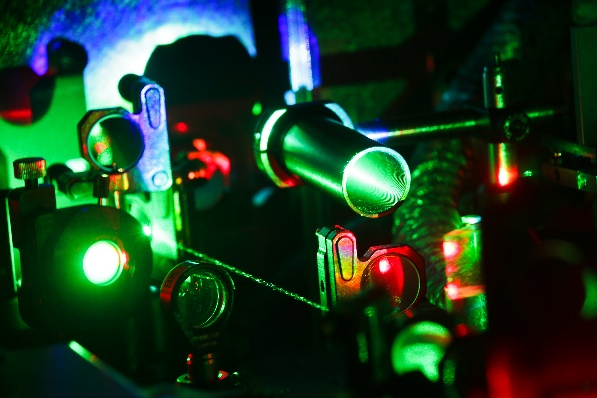Laser laboratory with ultrashort pulses
Laboratory with ultrashort pulses is equipped with a femtosecond titanium-sapphire laser Tsunami (Spectra-Physics). This laser has pulses with a length of 70 fs and a pulse energy of about 20 nJ, is tunable in the range 700 - 1030 nm, after doubling the frequency in the 350 - 565 nm range. The 80 MHz repetition rate can be reduced by a pulse picker to 4 MHz or less. A Hamamatsu streak camera (picosecond time resolution), semiconductor detectors and photomultipliers, Andor CCD cameras with spectrometers are available for detection.
In 2017, the laboratory was equipped with a unique laser system Rainbow (Spectra-Physics) with few-cycle pulses (< 7 fs). Thus, we have reached the physical boundaries of the time resolution in the visible spectrum. These ultrashort pulses can even be reduced to about 4.5 fs, which corresponds to just two oscillations of light. Such short pulse duration allows us to study the new type of physical phenomena occurring in materials during a single optical cycle. In addition, the system includes a system for carrier-envelope phase (CEP) stabilization.
From 2019 to now we have developed a new laser system in this laboratory, which serves for investigation of light-matter interaction in the strong-field regime, beyond the classical perturbative nonlinear optics. The system is based on in-house developed noncollinear optical parametric amplifiers pumped by solid-state femtosecond laser Pharos SP 6W (Light Conversion), which generate phase stabilized ultrashort pulses in the mid-infrared spectral range (wavelength of 1700-2300 nm) and pulses with duration of 6 fs in the near-infrared spectral region (650-1000 nm). These pulses are used to study coherent nonlinear optical processes such as high harmonic generation or tunneling regime of carrier excitation in solids. We can control the delay between the two-color pulses and measure dynamical processes in condensed matter with time resolution of few tens of femtoseconds. The detection of optical signals is performed using a wide range of tools ranging from classical grating-based optical spectrometers equipped with cryogenically cooled CCD cameras to vacuum ultraviolet spectrometer (wavelength range 80-200 nm) combined with microchannel plate detector.



